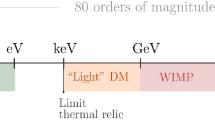Abstract
A new kind of dark-matter structures, ultracompact minihalos (UCMHs) was proposed recently. They would be formed during the radiation-dominated epoch if large density perturbations are present. Moreover, if the dark matter is made up of weakly interacting massive particles, the UCMHs can have effect on cosmological evolution because of the high density and dark-matter annihilation within them. In this paper, one new parameter is introduced to consider the contributions of UCMHs due to the dark-matter annihilation to the evolution of cosmology, and we use the current and future CMB observations to obtain the constraint on the new parameter and then the abundance of UCMHs. The final results are applicable for a wider range of dark-matter parameters.
Similar content being viewed by others
References
A.M. Green, A.R. Liddle, Phys. Rev. D 56, 6166 (1997).
M. Ricotti, A. Gould, Astrophys. J. 707, 979 (2009).
C. Schmid, D.J. Schwarz, P. Widerin, Phys. Rev. Lett. 78, 791 (1997).
G. Jungman, M. Kamionkowski, K. Griest, Phys. Rep. 267, 195 (1996).
G. Bertone, D. Hooper, J. Silk, Phys. Rep. 405, 279 (2005).
L. Bergstrom, New J. Phys. 11, 106005 (2009).
L. Zhang, X. Chen, Y.A. Lei, Z. Si, Phys. Rev. D 74, 103519 (2006).
L. Bergstrom, P. Ullio, J. Buckley, Atropart. Phys. 9, 137 (1998).
P. Ullio, L. Bergstrom, J. Edsjo, C. Lacey, Phys. Rev. D 66, 123502 (2002).
E.A. Baltz et al., JCAP 07, 013 (2008).
P. Scott, S. Sivertsson, Phys. Rev. Lett. 103, 211301 (2009).
A.S. Josan, A.M. Green, Phys. Rev. D 82, 083527 (2010).
Y. Yang, X. Huang, X. Chen, H. Zong, Phys. Rev. D 84, 043506 (2011).
B.J. Carr, K. Kohri, Y. Sendouda, J. Yokoyama, Phys. Rev. D 81, 104019 (2010).
B.C. Lacki, J.F. Beacom, Astrophys. J. Lett. 720, 67 (2010).
G. Bertone, A.R. Zentner, J. Silk, Phys. Rev. D 72, 103517 (2005).
X. Chen, M. Kamionkowski, Phys. Rev. D 70, 043502 (2004).
D. Larson et al., Astrophys. J. Suppl. 192, 16 (2011).
D. Zhang, arXiv:1011.1935.
O. Adriani et al., Nature 70, 043502 (2004).
J. Chang et al., Nature 456, 362 (2008).
Author information
Authors and Affiliations
Corresponding author
Rights and permissions
About this article
Cite this article
Yang, Y., Chen, X., Lu, T. et al. The abundance of new kind of dark-matter structures. Eur. Phys. J. Plus 126, 123 (2011). https://doi.org/10.1140/epjp/i2011-11123-8
Received:
Revised:
Accepted:
Published:
DOI: https://doi.org/10.1140/epjp/i2011-11123-8



